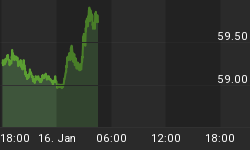The Consumer Metrics Institute is generally a pretty subdued bunch, as befits their job interpreting economic statistics for money managers and other economists. But lately they've been sounding, well, apocalyptic. Here are a few snippets from their analysis of the US GDP revision released this morning:
On the government's questionable use of inflation to arrive at real GDP:
"For this set of revisions the BEA assumed annualized net aggregate inflation of 1.26%. In contrast, during the first quarter (i.e., from December to March) the seasonally adjusted CPI-U index published by the Bureau of Labor Statistics (BLS) rose by 2.10% (annualized), and the price index published by the Billion Prices Project (BPP) rose at an annualized rate of 5.35%. As a reminder: an understatement of assumed inflation increases the reported headline number -- and in this case the BEA's relatively low "deflater" boosted the published headline rate. If the CPI-U had been used to convert the "nominal" GDP numbers into "real" numbers, the reported headline growth rate would have been a much more modest 0.96%. And if the BPP index (which arguably best reflects the experiences of the American consumer) had be used as the "deflater," the economy would have been reported to have been contracting at a -2.30% annualized rate."
On falling US imports:
"But once again that bad news was more than completely offset by an even larger drop in imports -- which now added +0.06% to the headline number after removing -0.32% in the prior report. Since this mathematical "addition" to the headline number can be the consequence of decreasing domestic demand for foreign goods, it is arguably a sign of a weakening economy. It may also be merely a sign of softening commodity prices."
And the big one, plunging incomes:
"And as mentioned above, real per-capita disposable income took another hit: it is now reported to have dropped by an annualized $796 from quarter to quarter. Real per-capita disposable income is now down $209 annually from 1Q-2011 -- a full two years ago."
Their summary:
"At best this new release reports an economy with lackluster growth, created at great expense by a combination of unprecedented fiscal and monetary stimulus that have obviously progressed well past the point of diminishing returns. To be fair, many other national governments would be thrilled to be reporting a 1.78% annualized growth rate. But that observation in itself (without mentioning the plunging export numbers) also reflect global economic headwinds that do not bode well for sustaining even lackluster numbers over the balance of the year.
And we continue to note the one truly serious domestic issue within the data:
- Real per capita disposable incomes took yet another hit. The astonishing annualized contraction of real per capita disposable income has now reached -9.21% -- dwarfing the -7.52% contraction rate recorded in the first quarter of 2009 (the worst quarterly contraction recorded during the official duration of the "Great Recession").
From time to time we may quarrel with the quality of the BEA's deflaters. And frankly we may even find that at face value the lackluster numbers amount to nothing more than a sham "recovery." But the most shocking part of this report is glaringly obvious from the real per capita disposable income numbers: all of the unprecedented fiscal and monetary stimulus has left American households materially worse off than they were two years ago."
Final thoughts
For the income of the average family to fall by 9% in one year is indeed a huge hit. The savings rate is around 3%, so for spending to be stable the other 6% would have to be drawn from savings or borrowed. Hence the falling imports (which might explain the recent bad news out of China). Now combine this with soaring mortgage ratesand CMI's opinion that this is "nothing more than a sham recovery" doesn't seem hyperbolic at all.
Ironically, for the financial markets cratering household income can be interpreted as good news because it will prevent the Fed from easing back on the monetary throttle. The question now is timing. Will the slowdown make it all the way to the top line -- with falling GDP in the second half of this year -- in which case we're back in 2008, staring into the abyss. Or do the financial markets anticipate never-ending debt monetization and keep blowing up the equity and bond bubbles? In which case we're in totally uncharted territory.
















